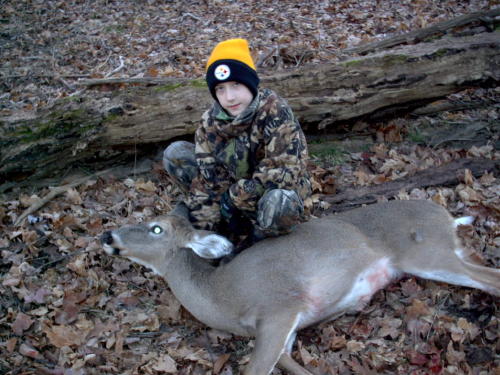|
Muzzleloader HuntingI received my first muzzleloader about 25 years ago. It was a replica of a 45 caliber Kentucky long rifle. No one in my family knew anything about loading or shooting muzzleloaders so we bought a book in hopes of learning all of the secrets. After some reading we purchased round balls, patches, black powder and a fancy brass powder flask. It was apparent real soon that something was wrong when we couldn’t get a patched round ball down the barrel. At one point we jammed one ball down the barrel and were afraid to shoot it. We had to have a bullet puller made to extract the lodged round ball. I then used the rifle by putting the round ball in without a patch for fear of getting another one stuck. On one particular day during the West Virginia muzzleloader season, a neighbor came along to try to drive some deer to me. When the day was done I think that I had missed about seven shots. At the end of the day I took an 80 yard shot at a stump and found that the round balls were hitting close to one foot low at this distance. This didn’t surprise me since the un-patched ball would have flown with little to no spin. This is one of those days that we still laugh about. We then purchased round balls that were smaller than the original. (0.440 as opposed to the original 0.445 diameter.) With the smaller round balls and a very thin patch we were finally able to shoot the 45 caliber with some accuracy at close distances. I was never successful hunting with this rifle but had many fun experiences. Modern Technology Before this year I had taken two shots at does, one an off hand long shot and another shorter shot. On the second occasion the shot was probably only about 35 yards. The doe was standing at the edge of a steep bank and I tried to shoot her in the neck hoping she wouldn’t go over the hill far. After the shot I told my son that she had been standing near a light spot on a particular tree. Why she did not go down right on the spot was puzzling. When we got to the spot on the tree marking where the deer had been standing we found that the light spot was where the bullet had hit the tree, obviously not hitting the deer. This year I finally connected on a doe. I hit her right behind the shoulder and the shot traveled through her heart and out behind the opposite leg. I found her about 50 yards from where she was standing at the shot. The shot was about 115 yards. Interesting how I missed those close shots and hit a longer one. They say a blind squirrel finds a nut every once in a while. I used a 50 cal. 40 grain Thompson Center Mag Express bullet and sabot combination on this doe. Hunting with a muzzleloader has been a lot of fun and an opportunity to spend a little more time in the woods. The year that I shot a nice 8 point buck in archery season I carried the muzzleloader much of the time during rifle season and my son and I got to see a lot of deer together. Muzzleloader Tips The second drawback is when powder gets damp or the cap will not fire properly. It is recommended that if you fire a muzzleloader and it does not ignite, that you continue to hold the rifle ready for it to fire for several seconds. This is sound advice. A couple of years ago I had hunted on a rainy day and my muzzleloader failed to fire at the end of the day. It finally fired about 5 seconds after the third cap was fired. I was still holding the rifle against my shoulder but had lifted my head. It was quite a surprise and I’m glad that I still had the rifle against my shoulder and a firm grip on the gun. Apparently the Pyrodex had become damp in the rainy weather. Shooting a muzzleloader is a lot of fun. If you are a gun nut they give you another rifle to tinker with, and if you just love hunting they give you another chance to spend time in the woods.
Manufacturers are now making some really nice muzzleloaders and at very reasonable prices. I like the new ones that have the break open action myself. They look like they are easy to operate, keep the cap protected and are easy to clean.
|

